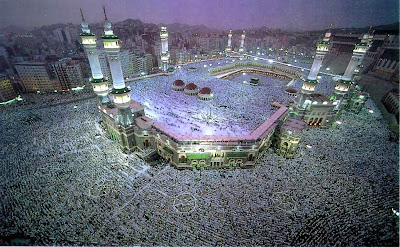Lecture 2
The Unifying Principles of
Islamic Architecture:
Tawhid (faith,unity & uniquely) &
Ihtiram-Adab (respect or propriety)
Prophet Period & Umayyad Architecture
Architecture as Tawhid: Unity & Uniquity of Allah
-
Essence of Tawhid to Allah: Shahada: Unity & Uniquity:
-
“There is no god but The God/Allah and Mohammad is his Messenger / Prophet”
-
“ There is no COMPULSION in ISLAM”
- But Once you declare/sign the CONTRACT of Shahada/ Syahadah you have to oblige to the LAW of ISLAM.
- Essence of Tawhid to Allah: Shahada: Unity & Uniquity:
- “There is no god but The God/Allah and Mohammad is his Messenger / Prophet”
- witness - truth tht Divine Reality is One, Eternal and w/o association
- Muslim – unified, borderless community transcends race, rank & wealth
- Notion of Tawhid: al Quran - haqiqa (formless essence) revelation/enlightenment - nature of space, forms, order, orients – place man the presence of Divine Unity
- Main architecture of Allah Unity & Uniquity is:
- Ka’bah : towards which Muslims face their five daily prayers
Kaaba
Located inside the Grand Mosque in Makkah, Saudi Arabia, it is cubic in shape and it is what determines the Qibla. It is an ancient stone structure that was built and re-built by prophets as a house of monotheistic worship. It is considered the centre of the Muslim world, and is a unifying focal point for Islamic worship. During the annual pilgrimage ("Hajj"), Muslims walk around around the Ka'aba in a counter-clockwise direction (a ritual known as "tawaf").
The Kaabah is a semi-cubic building that stands about 15 meters high and 10-12 meters wide. It is an ancient, simple structure made of granite. In the SE corner, a black meteorite (the "Black Stone") is embedded in a silver frame. Stairs on the north side lead to a door which allows entry to the interior, which is hollow and empty. The Kaabah is covered with a kiswah, a black silk cloth which is embroidered in gold with verses from the Qur'an. The kiswah is re-done and replaced once a year.
Architecture as Tawhid also contributed to urban planning as a law was implemented in the olden days to unify the city. This law was called the Fiqh Law whereby guides through everyday action and behaviour. In a more physical note, the law has implemented requirements that would shape the sizes of the streets, heights of houses, boundaries and many more. Zonings were also encouraged in the city to improve the way of living.
Architecture of Ihtiram: Respect, propriety or adab
(good manners) to God, fellow man and oneself
- Shahada: lack of propriety to others- as - lack of propriety with Allah swt. How is the believer expected to enter the Divine Presence/Paradise while showing impropriety towards Him?
-
5 pillars: shahada, salat (prayer), zakat (alms), fasting and hajj
- practice -encourages - respectful ‘consciousness’ to God
-
purify - improve conduct & build up inner and outer self
fulfillment, submit own will- to that of Allah
-
Muhammad pbuh- perfect eg. of propriety and praiseworthy
characteristics & example - perfect good manners
- AlQuran–guide-respect,as-virtue&attitudeofgood manners – transcendent- mindful of actions –respectful for the sake of Allah.
- self-conscious acts - courtesy to Him in all that we do: "The best of you are those who possess the best of manners."
- Muslim Architect- Islam as AdDin: practice Architecture -
submission - Allah- strives on path of purity - good habits and
keeping the heart away fr evil desires. practice -encourages -
respectful ‘consciousness’ to God
- During architecture practice- purify - improve conduct & build up inner and outer self fulfillment, submit own will- to that of Allah
- Work of architecture embodies this devotion more than the mosque; built to serve the pillar of religion, - the heart and unifier of the Muslim community.
- Islamic Architecture Symbolism:-symbolism,harmony and purity of geometry of the Ka’bah- are found in sacred architecture throughout the Islamic world. “God made the Ka’bah (the cube), the Sacred House, a symbol for mankind."Cube Geometry - linked -idea of ‘centre’. – fundamental - traditional architecture- synthesis of space:
-
- each face of the cube corresponding to the primary directions -
zenith and nadir;
-
- whilst the four corners point towards the cardinal points of the
universe.
-
Ka`bah - the underlying point of convergence between essential
cosmic principles and mosque architecture in the world.
UMAYYAD PERIOD ARCHITECTURE
The Umayyad period is often considered the formative period in Islamic art. As with the arts, the Umayyad period was also critical in the development of Islamic architecture. While earlier architectural traditions continued, the requirements of the new religion and customs of the new Arab rulers necessitated a different usage of space. In the case of religious buildings, the Umayyads often constructed their monuments on sites of historical or symbolic significance.
The Dome of the Rock in Jerusalem (691), the first major Umayyad architectural undertaking completed under the patronage of the caliph Abd al-Malik (r. 685–705), was built on a prominent site formerly occupied by Solomon's Temple and later associated with Muhammad's ascent to heaven. Other renowned religious buildings from the Umayyad period date from the reign of al-Walid (r. 705–15) and include the enlarged mosque in Medina (706–10), the former house of Muhammad. Also significant are the mosques of Damascus (706), where the site of the former Roman temple and fourth-century Byzantine church dedicated to Saint John the Baptist was transformed into the congregational mosque of the Umayyad capital, and of Jerusalem (709–15).
In terms of secular architecture, Umayyad desert palaces such as Mshatta, Qasr Amra (Jordan), Anjar (Lebanon), Khirbat al-Mafjar (Palestine), and Qasr al-Hayr East and West (Syria), are a testimony to the wealth of their patrons and the creativity of Umayyad architects.
 |
| Dome of Rock |





No comments:
Post a Comment